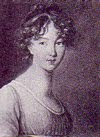The Wool Winder
(probably 1759)
Jean-Baptiste Greuze
(French, 1725-1805)
Oil on canvas, 74.6 x 61.3 cm
ID Number: 43.1.148
The Frick Collection
New York, New York
Finding the right materials with which to knit a reproduction of an item is, perhaps, the most difficult part of the process. I knit over four and a bit centuries, from the 16th to the present day. Many of the objects that I reproduce are made using the original one as inspiration or a model whether I can examine the piece myself or am working from photographs or paintings. The 16th through early 19th centuries are the most challenging. I am continually searching for wool, linen, silk and cotton that will resemble those of the past. Contemporary versions possess a very taut twist, all very much looking machine made. If I am knitting in the Industrial Age, I am still wondering if my materials resemble machine spun threads of that era.
Wool offers more choice and accessibility. I can spin or have wool spun for me to my weight or plying specifications. I am also able to obtain naturally dyed wool, that is, wool being dyed with indigo, cochineal, vegetables and plants using 18th century methods. It is possible to find commercial wools that will pass in reproduction knitting. Jamieson’s, Morehouse, Blackberry Ridge, Harrisville Designs offer fine weight wools in acceptable colours after careful research. I have also recently added some glorious undyed Wool out of Wales to the reproduction stash.
Nineteenth century knitting is, of course, much easier to replicate as by the late 1830’s and early 1840’s, patterns, although laconic, were appearing and knitting materials (type of needles and wool or cotton) were often suggested. This continued throughout the century even, sometimes, with the suggestion of colours for their durability to retain their dye through wear and washing and not always as a fashion statement. The range and accessibility of materials were, thanks to mass industrialization, much wider. Wools, silks and cottons were specifically named and needle sizes begin to be standardized. Books and periodical publications about needlework from this era are still widely available online, in facsimile and original editions in libraries. The last mentioned often have a section describing materials, in less or more detail, such as found on http://www.robinstokes.com/yarn_names.htm
Some of my reproduction knitting takes me through the early 20th century right up to the 1930’s and by then it is much easier to match wools and cottons if not actually find them sometimes. Damaged vintage garments can be unraveled for period knitting. I was lucky enough to have inherited wool in different weights from the 1950’s and 1960’s and poking about in antique shops has yielded vintage fine cotton. My dream, however, is to find some (silk) twist from c. 1800!

